Emmanuel Kwesi Nyantakyi1, Abena Obiri-Yeboah2, Nana Kwame Obeng-Ahenkora1, Martin Kyere Domfeh1, Ghadafi Abdullai Mohammed2
1Department of Civil and Environmental Engineering, University of Energy and Natural Resources, Sunyani, Ghana
2Department of Civil Engineering, Kumasi Technical University, Kumasi, Ghana
Correspondence to: Emmanuel Kwesi Nyantakyi, Department of Civil and Environmental Engineering, University of Energy and Natural Resources, Sunyani, Ghana.
| Email: |  |
Copyright © 2020 The Author(s). Published by Scientific & Academic Publishing.
This work is licensed under the Creative Commons Attribution International License (CC BY).
http://creativecommons.org/licenses/by/4.0/

Abstract
The administration of Health and Safety is an issue that is significant and pivotal to all organizations across all businesses worldwide. This integrates conventional and commercial businesses, data innovation (IT), care homes, schools, higher instructive teaching, travel and relaxation among others. The construction industry in the nation has always suffered due to hazardous working conditions. Occupational Health and safety is specifically significant and vital for the construction industry. The construction industry has a global reputation for the quality of work but, however, remains one of the most dangerous industries within the country. Contractors, subcontractors and their workforce quite frequently face varied risks from hazards which could result in injuries, other illnesses and even deaths in severe instances. This study investigated occupational health and safety on selected construction sites in the Sunyani Municipality in Ghana. Three different sets of questionnaires were distributed to and interviews conducted for consultants, contractors and construction workers in the Building Construction Industry. The focus of the interviews and questionnaires included accident origins, health and safety policy and management, factors affecting health and safety and reporting schedules. The results indicated that the factors responsible for most accidents on construction sites are workforce situations and management operations. It was also revealed that lack of PPE’s, technical guidance, training, safety knowledge and fatigue could seriously affect health and safety on construction sites either as one or in combination. The study recommended the enforcement of safety protocols on all construction sites and a progressively consistent and sustainable health and safety educational campaign programmes to enhance awareness of the negative implications of lack of health and safety procedures on site.
Keywords:
Ghanaian Construction Industry, Occupational Health and Safety, Sunyani Municipality
Cite this paper: Emmanuel Kwesi Nyantakyi, Abena Obiri-Yeboah, Nana Kwame Obeng-Ahenkora, Martin Kyere Domfeh, Ghadafi Abdullai Mohammed, Investigating Occupational Health and Safety of Workers on Selected Construction Sites in the Sunyani Municipality, Ghana, Journal of Safety Engineering, Vol. 9 No. 1, 2020, pp. 1-8. doi: 10.5923/j.safety.20200901.01.
1. Introduction
The health and safety performance of the construction sector is an important issue in Ghana’s implementation of the Millennium Development Goals (Laryea and Mensah, 2010). The construction sector in developing countries plays a significant role in its physical development and employment of the otherwise largely unemployed labour force. It is not surprising that construction in developing countries contributes a large quota to occupational accident statistics. Compared with developed countries, construction sites in developing countries are ten times more dangerous than in developed countries (Kanchana et al, 2015). According to Anim et. al (2019), the Ghanaian construction industry even though contributes a lot to the GDP, happens to be the most hazardous industry after manufacturing. Small and medium-scale businesses dominate the construction industry in many developing countries. In Ghana, Addo-Abedi (1999) reported that virtually all domestic construction businesses operate as small-scale contractors managed by owners/managers and their spouses and in some cases, their children. These small and medium enterprises (SMEs) are constrained by limited access to financial and information resources as well as regulations and procedures which make it difficult to effectively manage the health and safety aspects of their operations (Avevor, 2016). The quality of working conditions within SMEs is therefore relatively unsatisfactory when compared with working conditions in large construction businesses within developing countries (Kheni et al, 2010). Considering that a sizeable proportion of the labour force in construction is employed within construction SMEs, it raises a level of concern for health, safety and welfare within the SME sector in construction as many workers are exposed to different hazards on site.The Government of Ghana in its development strategy (Government of Ghana (GOG), 2005) aims to move the country into a full middle-level income country by the year 2015. This requires commitment by Government to improve productivity of all economic sectors of the country. For this to be achieved, working conditions need to be improved, particularly for construction. Anaman and Osei-Amponsah (2017) have shown that Ghana’s construction industry has potential as a driver of economic growth, although Government’s commitment to improving productivity of the sector is low. Improving the health and safety performance of the sector is one means of enhancing the productivity of the construction sector in Ghana.In Ghana a lot of workers lose their lives through accidents on construction sites, others become physically handicapped through similar means (Amponsah-Tawiah and Dartey-Baah, 2011). Workers are seen working on site without observing any safety standards such as wearing of protective clothes, helmets, goggles, overalls, safety boots and gloves. Meagre sums of monies are given to those who become accident victims on construction sites as compensation. This is because most of the workers in the construction site are employed on contractual basis and not permanent and therefore do not enjoy most of the privileges permanent staff enjoy including workers’ compensations. Statistics from the construction sector in Sunyani shows that there were 163 all-male non-fatal accidents and 4 all-male fatal accidents between the years 2000 and 2019. The International Labour Organisation (ILO) estimates at least 60,000 fatal accidents a year on construction sites around the world which is one in six of all fatal work-related accidents. The global trade union federation puts the figure much higher at 108,000 with construction being responsible for 30% of all work-related accidents (Rotifa and Eguvbe, 2017), Many more workers suffer from work related injuries and from occupational diseases arising from exposure to dangerous substances such as dust, chemicals and asbestos among others. According to the United States Department of labour on Occupational safety and Health Administration, casualties in the construction industry accounted for 21.1% of worker fatalities in the private industry in 2018. The ILO in 2001 estimated the number of deaths from accidents at workplaces in India at 40,000, with an additional 262,000 dying from work-related diseases and another 65,000 from dangerous substances. If construction is responsible for one-sixth of the total, deaths among Indian construction workers can be estimated at over 60,000 each year (Dainty and Loosemore, 2012).In Britain, 2.2 million people work in the construction industry making it the country’s biggest industry (Hughes and Ferrett, 2016). In the last 25 years, over 2,800 people have died from injuries they received as a result of construction work (Uduakobonge et. al 2016). In 2004/05 according to Health and Public Services Committee (2005), London's construction sector had one of the highest rates of fatal and major injuries (301.6 injuries per 100,000 workers) and the highest rate of 3-day injuries (608.2 injuries per 100,000) in the country. Approximately 230,000 people (roughly 5% of London's workforce) work in the construction sector in London. The construction sector employs 5% of London's workers, but accounts for 50% of fatal injuries and nearly 20% of major injuries in the city's workplaces.While securing a job in construction offers a potential route out of poverty for many of the world’s poorest, subsequent inability to work due to injury or ill-health can drive them and their families back into destitution (Wells and Hawkins, 2019). It is in this view and the alarming results on occupational health and safety concerns in both developing and developed countries that this study arose. The objective is to investigate occupational health and safety of workers on some selected construction sites in the Sunyani Municipality of Ghana. It is envisaged that the results will inform and influence policy and decision makers for a safer construction industry within the Municipality. Figure 1 shows a map of the study area.  | Figure 1. Map of the city Sunyani |
2. Materials and Methods
2.1. Method of Data Collection
Primary data was collected through administration of questionnaires to construction sites and offices, and also from face to face interviews on the sites.
2.2. Site Visits
Surveillance visits were made to some selected construction sites in the Sunyani Municipality to observe the general health and safety protocols on each site. This was necessary to corroborate the findings from the questionnaire results and the interviews. Questionnaire respondents were classified as Consultants and Project managers (Architects, Quantity Surveyors, Clerk of works, Engineers), Contractors (Project managers, Site Engineers, Foremen, Supervisors) and Workers (masons, carpenters, steel benders, labourers). Equation 1, the Kish Formula was used to determine the sample sizes for the three respondent categories. As a result, a total of 55 questionnaires were administered. The results are analyzed and discussed in the subsequent sections.  | (1) |
Where, = Sample size
= Sample size  = S2/V2 where V = the standard error of sampling distribution = 0.05 and S = the maximum standard deviation of the populationN = Total number of registered contractors in the MetropolisFactors within the survey were positioned based on the reaction of the participants utilizing Mean Relative Analysis (MRA). The mean score obtained was based on the five-point Likert scale. The equation for the MRA is:
= S2/V2 where V = the standard error of sampling distribution = 0.05 and S = the maximum standard deviation of the populationN = Total number of registered contractors in the MetropolisFactors within the survey were positioned based on the reaction of the participants utilizing Mean Relative Analysis (MRA). The mean score obtained was based on the five-point Likert scale. The equation for the MRA is:  | (2) |
Where, n5, n4, n3, n2, n1 = number of respondents who replied from strongly agree to strongly disagree. This positioning aided determination of factors affecting health and safety on construction sites. The appraisals were compared with the hypothetical mean rating of 4.25 to decide the major factors that affect health and safety on the selected construction sites in the Sunyani Municipality.
3. Results and Discussion
3.1. Analysis of Data
 | Figure 2. Presence of health and safety officer |
 | Figure 3. Health and safety plan for works |
 | Figure 4. Training of workers on Health and Safety |
 | Figure 5. Classification of Firms |
 | Figure 6. Position of respondent in firm |
 | Figure 7. Health and Safety plan for projects |
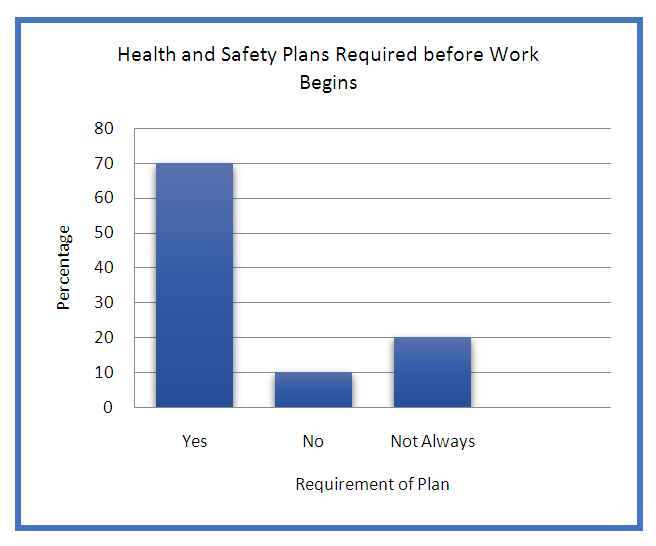 | Figure 8. Requirement of health and safety plan outline of contractor |
 | Figure 9. Complaints of health and safety |
3.2. Analysis of Findings from Contractor’s Questionnaire
The health and safety of workers on construction sites is vital to the sustainability of the industry as an infrastructure provider (Willar et. al 2020). The opinion of top management and operatives themselves as to how health and safety should be carried out on site most often than not reveals conflicting results. It is interesting to note that the nature of the firm in terms of it being local (Ghanaian), foreign or local and foreign partnership does affect the presence of a health and safety policy in the firm. It is sad to observe that many local construction companies within the Sunyani Municipality do not have any comprehensive safety policies. There is no evidence or trace that a written document in the firm covers the viewpoint of the firm on health and safety. The presence of safety officers on some sites is a step towards the reduction of accidents, however, the study revealed that many of the firms operating within the Municipality do not have safety officers.
3.3. Opinion of Management on the Provision of Personal Protective Equipment
From Table 1, it can be deduced that 75% of project managers claim to provide personal protective equipment (PPE) to workers, 6.25% do not make any provision for PPE while another 18.25% do not always provide their workers with PPEs.Table 1. Provision of PPEs to Workers
 |
| |
|
With reference to Table 2, half of the respondents (50%) do not always keep records on health and safety while 31.3% regularly keep records of all activities related to health and safety on construction site. Majority of project managers do not keep records which hinder the prime objective of ensuring safety protocols on site. Table 2. Health and Safety Record Keeping
 |
| |
|
3.4. Findings from Consultant Questionnaires
Consultants have a significant role to play in ensuring that the work place is safe for workers. They also have to ensure the implementation of health and safety rules by contractors on site. Table 3 shows that routine discussion between consultants and their contractors on health and safety issues vary. Table 3. Discussion on health and safety issues
 |
| |
|
Consultants who go on daily routine inspections happen to discuss safety related issues every time they have site meetings. It was found that discussion of health and safety issues during site meetings help in ensuring health and safety of both workers and managers on site. Sixty (60%) of consultants have safety discussions while 40% said they do not always do it. But none of them responded that they do not do it at all. The presence of an officer in charge of health and safety related issues on site influences accident investigations on site. It is deduced that consulting firms with a safety officer present had almost all cases of accidents investigated. Majority (80%) of these firms with no safety officers have accident cases not always investigated while only 20% of these cases are investigated at all (See Table 3). Table 4 gives an examination of the reporting/recording of accidents that occur on site from consulting firms.Table 4 indicates that, 40% of contractors report occurrence of accidents on site to consultants while 10% of contractors do not report it at all. Consequently, 50% of contractors do not always report accidents to their consultants. Table 4. Reporting of accidents
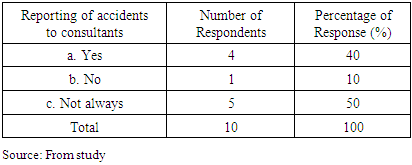 |
| |
|
The presence of an instituted health and safety plan for construction work by consultants is a step to demanding a comprehensive health and safety plan outline of contractors before commencement of work on site. Most (70%) consulting firms with pre-plan health and safety policies demand health and safety plan outlines and method statements from contractors before work begins. A small percentage (10%) of firms with no pre-plan safety policy do not request contractors to produce a health and safety policy for projects. It is also very important to note that 20% of these firms despite having no pre-plan policy, however, do not always require contractors to produce a safety plan outline for the works as in Table 5.Table 5. Pre-plan policy of consultant and demand of outline from contractor
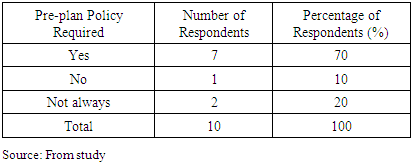 |
| |
|
3.5. Findings from Workers Questionnaire
Not only do contractors and consultants have a significant role to play in ensuring that the work place is safe, but workers on projects should also play a key role to help in enhancing health and safety on the construction site. Health and safety must be seen as a joint responsibility and regulations on health and safety provide a duty for workers to ensure their personal health and safety on construction sites.Table 6 is the result of variable ranking which shows lack of PPE’s, technical guidance, training, safety knowledge and fatigue with mean values of 4.55, 4.41, 4.38, 4.31 and 4.28 are major factors that affect health and safety on construction sites in the Sunyani Municipality. This result corroborates the findings of previous studies as the mean score of the opinions of respondents in Table 6 confirms the findings of Durdyev et al (2017), Kanchana et al (2015) and Agyekum et at (2018). A critical look shows that the most important factor affecting health and safety on construction sites in Sunyani was the lack of PPE’s. It is the responsibility of management to provide workers with the necessary protective garments on construction sites. PPEs play an unmistakable part in guaranteeing the general wellbeing and safety of workers on site which unavailability puts workers at risk of getting injured thus defeating the purpose of ensuring health and safety on construction sites (Bruni and Natalia 2012).Table 6. Factors affecting health and safety on construction sites in the Sunyani Municipality
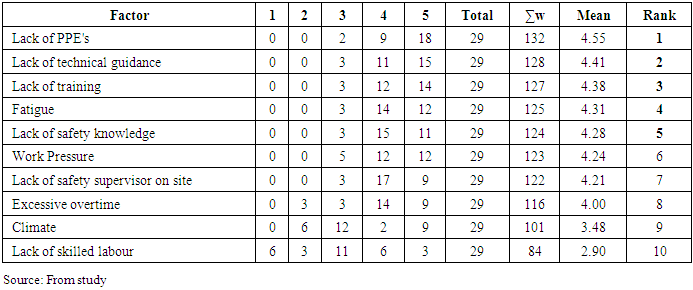 |
| |
|
The factors affecting health and safety on construction sites in the Sunyani Municipality were then analyzed using a simple bivariate correlation to determine their relationship (Table 7). The results exhibited multicollinearity among the factors while a two tailed Spearman correlation matrix was applied to determine the direction of the relationship. The relationship between lack of safety supervisor and fatigue had the highest correlation coefficient (r = 0.701; p < 0.01). Thus, lack of safety supervisors on site is directly linked to the fatigue they endure in the course of their deliberations. This suggests that should these personnel get the required rest, there will be a significant improvement in their turn up or presence at their respective sites. Table 7. Relationship between factors affecting health and Safety on construction sites in Sunyani
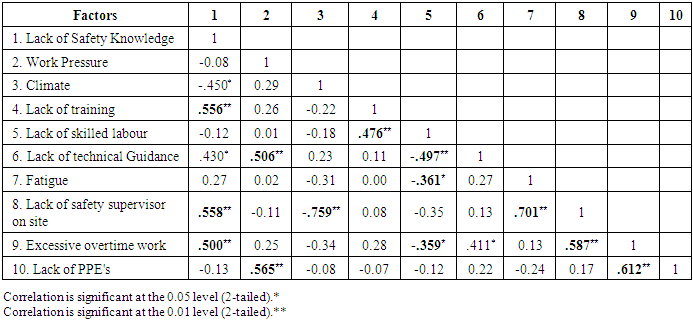 |
| |
|
A positive relationship exists between lack of training and lack of skilled labour (r=0.476; p <0.01) and lack of safety knowledge (r = 0.556; p < 0.01). Health and Safety training is basically meant to impart the workforce with knowledge and skills to enhance safer work performance for workers (Vinodkumar and Bhasi, 2010). The absence of this training basically reduces the level of knowledge on safety by workers and vice versa (Nkrumah et al. 2020). Lack of safety knowledge had a positive relationship with lack of technical guidance (r = 0.430; p < 0.05), lack of safety supervisor on site (r=0.558; p <0.01) and excessive overtime work (r=0.500; p <0.01). This implies lack of safety knowledge results in lack of technical guidance in relation to health and safety on construction sites which can result in injuries and accidents on site (Vitharana et al, 2015).Lack of safety supervisors on site related positively with excessive overtime work (r=0.587; p <0.01) indicating an adverse effect on plant, equipment and personnel involved, is observed as a result of excessive overtime work from lack of safety supervision on site. It was noted that, personnel may overwork themselves thereby overstretching plant and equipment which leads to more accidents occurring. Work pressure recorded a positive association with lack of technical guidance (r=0.506; p <0.01) and lack of PPE’s (r=0.565; p <0.01). This shows increasing work pressure goes with increasing lack of technical guidance and PPE’s. Work pressure goes up when personnel satisfy company’s needs to keep their jobs and protect themselves even when they lack the needed technical guidance and PPE’s to prove their competence. Lack of training yielded a positive relationship with lack of skilled labour (r=0.476; p <0.01). Lack of training gave rise to lack of skilled labour witnessed at the labour front (Durdyev et al, 2017). In this regard, if personnel are oriented and acquainted with the requisite training in their fields of expertise, skilled labour drastically increases.However, a negative relationship was established between climate and lack of safety supervisor on site (r= -0.759; p <0.01); the influence of work climate has no adverse implication on lack of safety supervisor on site. Conversely, lack of supervisors on site has no significant impact on the work climate. Again, lack of skilled labour recorded a negative relation with lack of technical guidance (r= -0.497; p <0.01). This indicates that lack of skilled labour is not as a result of lack of technical guidance and vice versa. Although they all pose a threat to the company, their impacts are independent of each other.
4. Conclusions
The study looked at factors affecting health and safety on site. Management and workers have a dual responsibility for ensuring health and safety on construction site. The factors that affect health and safety positively are lack of safety knowledge, work pressure, training, skilled labour, technical guidance, fatigue, safety supervisor, PPEs and overtime work while work climate was found to have no implication on health and safety at the construction site. Health and safety consciousness seem to vary considerably from building construction activities to civil construction works. There is a very poor mechanism for record keeping of safety issues. Education of workers on their health and safety is virtually non-existent in the Sunyani Municipality.
5. Recommendations
The study recommends a comprehensive legislation to govern health and safety of construction activities in the Sunyani Metropolis and the country as a whole and the need for clients to make commitment to ensuring health and safety of all operatives. Consistent and sustainable educational programmes should be put in place by construction firms to enhance awareness of the consequences of health and safety on site. A monitoring and evaluation system should be institutionalized to enforce health and safety on Ghanaian construction sites. A more proactive industry can be created if Government, consultants and contractors are willing to present and address the problem of health and safety on site through proper legislations, implementation and enforcement of policies on health and safety.
References
| [1] | A guide to the Reporting of Injuries, Diseases and Dangerous Occurrences Regulations 1995 L73 (Second edition) HSE Books 1999 ISBN 0 7176 2431 5. |
| [2] | Addo-Abedi, F Y (1999) Sustained development of the local contracting industry in a developing country. In: Proceedings of the Second International Conference on Construction Industry Development, 27-29 October. |
| [3] | Agyekum, Kofi & Simons, Barbara & Botchway, Seth. (2018). Factors influencing the performance of safety programmes in the Ghanaian Construction Industry. 25. 39-68. 10.18820/24150487/as25i2.2. |
| [4] | Amponsah-Tawiah, K. and Dartey-Baah, K. (2011). Occupational Health and Safety: Key Issues and Concerns in Ghana. International Journal of Business and Social Sciences. Vol. 2. 119-126. |
| [5] | Anaman, K. and Osei-Amponsah, C., (2017). How the growth of the construction industry can help accelerate economic development. 10.13140/rg.2.2.16546.84165. |
| [6] | Avevor, E. E. (2016). Challenges faced by SMEs when accessing fund from financial. |
| [7] | Construction safety association of Ontario, Construction Safety, Revised edition 2003 ISBN 0-919465-88-9. |
| [8] | CIS46 HSE Books 1997, Health and safety in construction HSG150 (Second edition) 2001, ISBN 0 7176 2106 5. |
| [9] | Dainty, A. and Loosemore, M., 2012. Human Resource Management In Construction. 2nd ed. London: Routledge, p.155. |
| [10] | Durdyev, S., Mohamed, S., Lay, M and Syuhaida I., (2017). Key Factors Affecting Construction Safety Performance in Developing Countries: Evidence from Cambodia. Australasian Journal of Construction Economics and Building. 17. 48-65. 10.5130/AJCEB.v17i4.5596. |
| [11] | Health and Public Services Committee. (2005). Building London, saving lives, (November), 34. |
| [12] | HSE Books 2002, Essentials of health and safety at work (Third edition) ISBN 0 7176 2534 6. |
| [13] | Hughes, P. and Ferrett, E., 2016. Introduction to Health and Safety in Construction. 1st ed. New York: Routledge, p.182. |
| [14] | INDG347 HSE Books 2002, Basic advice on first aid at work, ISBN 0 7176 2261 4. |
| [15] | Kanchana, S., Sivaprakash, P., and Joseph, S. (2015). Studies on labour safety in construction sites. Scientific World Journal, 2015. https://doi.org/10.1155/2015/590810. |
| [16] | Kheni, N. A., Alistair G. F. Gibb & Andrew R. J. Dainty. (2010). Institutional and Economic challenges to health and safety management within SMEs in developing countries: a case study of Ghana. Journal of Construction Engineering and Management, 136(10), 527–540. https://doi.org/doi:10.1061/(ASCE)CO.1943-7862.0000218. |
| [17] | Laryea, S. and Mensah, S., (2010). Health and safety on construction sites in Ghana. COBRA 2010 - Construction, Building and Real Estate Research Conference of the Royal Institution of Chartered Surveyors. |
| [18] | Nkrumah, E., Gyabeng, E., and Akoto, L., (2020). The State of Occupational Health and Safety Management Frameworks (OHSMF) and Occupational Injuries and Accidents in the Ghanaian Oil and Gas Industry: Assessing the Mediating Role of Safety Knowledge. BioMed Research International. 10.1155/2020/6354895. |
| [19] | Rotifa, S. and Eguvbe, O, (2017). Safety Practices and Knowledge of Construction Workers on Hazards Associated with Working on Road Construction Sites in Egor Local Government Area of Edo State. World Journal of Preventive Medicine. 5. 19-25. 10.12691/jpm-5-1-3. |
| [20] | Uduakobonge E., Udo, E.E., and Christian F. (2016). Effect of Lack of Adequate Attention to Safety Measures on Construction Sites in Akwa Ibom State, Nigeria. Journal of Earth Sciences and Geotechnical Engineering, 6(1), 113-121. |
| [21] | Vitharana, Hashini & de silva, Subashi & De Silva, Sudhira. (2015). Health hazards, risk and safety practices in construction sites – a review study. Engineer: Journal of the Institution of Engineers, Sri Lanka. 48. 35. 10.4038/engineer. v48i3.6840. |
| [22] | Vinodkumar, M.N. & Bhasi, M. (2010). Safety management practices and safety behaviour: Assessing the mediating role of safety knowledge and motivation. Accident; analysis and prevention. 42. 2082-93. 10.1016/j.aap.2010.06.021. |
| [23] | Wells, J., and Hawkins, J. (2019). Promoting Construction Health and Safety through Procurement: A briefing note for developing countries Dr Jill Wells Programme Officer, Engineers Against Poverty Briefing note, (March). Retrieved from http://suo.im/6u7kyC. |
| [24] | Willar, D., Waney, E.V.Y., Pangemanan, D.D.G. and Mait, R.E.G. (2020), "Sustainable construction practices in the execution of infrastructure projects: The extent of implementation", Smart and Sustainable Built Environment, Vol. ahead-of-print No. ahead-of-print. https://doi.org/10.1108/SASBE-07-2019-0086. |
| [25] | Workplace (Health, Safety and Welfare) Regulations 1992 Approved Code of Practice and Guidance (external site). |





 = Sample size
= Sample size  = S2/V2 where V = the standard error of sampling distribution = 0.05 and S = the maximum standard deviation of the populationN = Total number of registered contractors in the MetropolisFactors within the survey were positioned based on the reaction of the participants utilizing Mean Relative Analysis (MRA). The mean score obtained was based on the five-point Likert scale. The equation for the MRA is:
= S2/V2 where V = the standard error of sampling distribution = 0.05 and S = the maximum standard deviation of the populationN = Total number of registered contractors in the MetropolisFactors within the survey were positioned based on the reaction of the participants utilizing Mean Relative Analysis (MRA). The mean score obtained was based on the five-point Likert scale. The equation for the MRA is: 








 Abstract
Abstract Reference
Reference Full-Text PDF
Full-Text PDF Full-text HTML
Full-text HTML





